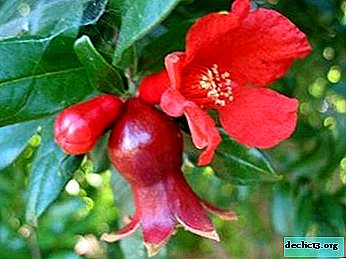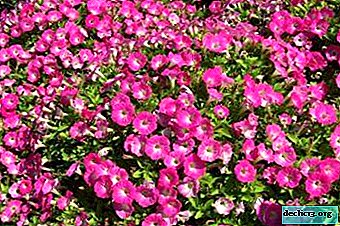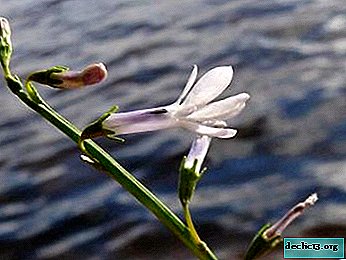Spectacular beauty: how to make epiphyllum bloom at home and what varieties are suitable for this?

Epiphyllum is often grown as a room culture. Such popularity is caused by its spectacular flowering.
For the beauty of the flowers, the epiphyllum is called the cactus orchid. But sometimes phyllocactus for some reason does not pick up buds for a long time, and not everyone knows how to make it bloom.
Our article will tell about this, and also learn how to properly care for this plant.
Flowering plant varieties
In nature, there are 20 species of epiphyllum. Breeders have developed many hybrid varieties that can be grown at home. All species bloom beautifully.
Particularly popular with gardeners:
- angular epiphyllum (Epiphyllum anguliger);
- Ephyllanthus (Epiphyllum phyllanthus);
- Hooker epiphyllum (Epiphyllum Hookeri);
- jagged (Epiphyllum crenatum);
- Ackerman (Epiphyllum Ackermanii);
- Just Pru (Epiphyllum Just Pru);
- epiphyllum acid-petal (Epiphyllum oxypetalum);
- Lau (Epiphyllum Laui);
- Epiphyllum Paul de Lonpre (Epiphyllum Paul de Lonpre).
Epiphyllum flowering most often occurs in April - Julyless often in the fall. Each flower lasts about five days. In good conditions, the plant is able to bloom again in the fall. In this case, it does not hibernate.
Process description
The buds are laid on the thickening of shoots located at the ends of the stems. They begin to unfold in turn. Each flower bud forms a flower only once during life, then dies.
The flowers are large, funnel-shaped, with a long corolla tube. They can reach 40 centimeters in length. Their diameter, depending on the variety, is from 8 to 25 centimeters. The color of the corollas can be white, cream, yellow, lemon, orange, pink, red. The ovary and tube are covered with hairs or small spines. The flowers have a delicate aroma, open in the daytime or at night.
Photo
In the photo below you can see the blooming epiphyllum.





How to extend it at home?
From the end of February, put the plant in a warm place, increase watering. In spring, stimulate the epiphyllum to awaken with a warm shower. Soon thickenings appear on the shoots, from which flowers develop. In March - April, flower buds are laid and buds are formed.
During this period, you can not turn the pot with the plant and rearrange it to another place, otherwise the buds will fall off. It is required to increase the temperature and increase the frequency of watering. Add the first top dressing.
During flowering, water so that between the procedures the soil in the pot remains slightly moist. Keep at a temperature not lower than + 15 ° С, optimal indicators are from +20 to + 25 ° С. Feeding once every two weeks with special fertilizers for cacti. Do not spray. If you provide good conditions, the epiphyllum will bloom again in early autumn.
Follow-up care
In summer, after flowering, the epiphyllum is kept outdoors or away from the window. The plant is shaded, protecting from direct sunlight. The room maintains a temperature of +20 to + 25 ° C and high humidity. The plant is sprayed with warm, settled water no more than once a week. Continue to feed. If necessary, carry out activities for propagation by cuttings or dividing the bush.
In August, you can transplant a plant if the pot has become cramped. Since September, reduce watering, make the last top dressing. Since December, the epiphyllum enters a state of rest. The plant is transferred to a room with a temperature of +12 to + 15 ° C and low humidity. Or simply clean from direct sunlight and protect from the effects of heating radiators. Provide diffuse lighting. Watering sparingly and rarely. Read more about caring for this beautiful plant in a separate material.
Fruits of phyllocactus
 Epiphyllum is able to bear fruit even at home. This requires artificial cross-pollination. Fruits are often covered with thorns, in shape and size similar to a plum. Their color depends on the shade of the flowers.
Epiphyllum is able to bear fruit even at home. This requires artificial cross-pollination. Fruits are often covered with thorns, in shape and size similar to a plum. Their color depends on the shade of the flowers.
There are yellow-green or purple fruits. You can eat them. The pulp has a pleasant sweetish taste, reminiscent of a mixture of pineapple with strawberries. Fruits are eaten separately, like fruits or berries, and also added to various dishes. Pre-cleaned of thorns. The fruits are used in folk medicine. On the basis of the pulp, infusions, ointments and compresses are prepared.
These funds help in the treatment of headaches, colds, diseases of the cardiovascular, genitourinary and nervous system, gastrointestinal tract, skin and joint diseases. The fruits are especially widely used in the fight against psoriasis.
Why does the plant not pick up buds, and how to make it bloom?
Attention! Young epiphyllum is not capable of flowering. The plant should be three to four years old. If for some reason the adult does not do this, the rules of care are violated.Main reasons:
- lack of light;
- watering errors;
- improper temperature and humidity;
- defective top dressing;
- lack of fresh air;
- untimely transplants;
- too spacious pot;
- untimely removal of old shoots;
- lack of rest period.
To cause flowering, you need to create special conditions:
 A lot of light. Choose a place for the epiphyllum on the windowsill of the east or west window. If only the north direction is available, place the plant near the glass itself. In such conditions, flowering can be achieved, but it will not be magnificent. On the southern windowsill, the epiphyllum is slightly shaded with gauze or a tulle curtain. The open sun is detrimental to the plant.
A lot of light. Choose a place for the epiphyllum on the windowsill of the east or west window. If only the north direction is available, place the plant near the glass itself. In such conditions, flowering can be achieved, but it will not be magnificent. On the southern windowsill, the epiphyllum is slightly shaded with gauze or a tulle curtain. The open sun is detrimental to the plant.- The correct watering regime. In winter, during the rest period, it is rare to moisten the soil with small portions of water. In a cool room, one watering per month is enough, in a warm room - two times. If the epiphyllum bloomed in the fall, do not stop watering. Hibernation lasts three months. In February - March, increase the frequency of watering. The soil should not be allowed to dry, otherwise the aboveground part of the cactus will begin to die. Use settled water at room temperature.
- Correct temperature conditions. In summer, indicators should be in the range from +20 to + 25 ° C. In autumn you can keep epiphyllum on the balcony or loggia. When the night temperature drops to + 5 ° C, transfer to the room. A successful wintering takes place at indicators from +12 to + 15 ° C.
- Fresh air. In the summer, the epiphyllum feels more comfortable on the balcony or on the street than indoors.
- Timely removal of old shoots. Pruning is done in the spring, before the start of the growing season. Such events are held every two to three years. Old shoots do not bloom; they must be removed to stimulate the growth of young stems. Thin shoots sometimes grow. Flowers are not laid on them, it is better to cut them so that the plant does not spend its strength. Leave strong wide stems.
- Timely transplant. It is not recommended to transplant the plant often. After each change of the pot, the active development of the root system begins, which prevents the growth of stems and the laying of flower buds. Young specimens are transplanted every two years, adults - every three or four years. The event is held in late spring or early summer, after the end of the flowering period. Use the transshipment method so as not to damage the roots.
- Full nutrition. In the spring-summer period, fertilizers for cacti are applied every two weeks. In winter, top dressing is not needed.
- A pot of the appropriate size. Epiphyllum blooms when the roots become cramped in the container. A shallow pot is suitable. When transplanting, take a new flowerpot two to three centimeters wider than the previous one.
- Rest period. Provide a cool wintering with limited soil moisture.
Epiphyllum blooms only when properly maintained. During dormancy, coolness and a minimum of humidity are required. When buds are being laid, the epiphyllum should not be disturbed.
After flowering, air baths in the fresh air and spraying are useful. If you follow all the recommendations, an adult epiphyllum will surely delight its owner with magnificent flowers.

 A lot of light. Choose a place for the epiphyllum on the windowsill of the east or west window. If only the north direction is available, place the plant near the glass itself. In such conditions, flowering can be achieved, but it will not be magnificent. On the southern windowsill, the epiphyllum is slightly shaded with gauze or a tulle curtain. The open sun is detrimental to the plant.
A lot of light. Choose a place for the epiphyllum on the windowsill of the east or west window. If only the north direction is available, place the plant near the glass itself. In such conditions, flowering can be achieved, but it will not be magnificent. On the southern windowsill, the epiphyllum is slightly shaded with gauze or a tulle curtain. The open sun is detrimental to the plant.















